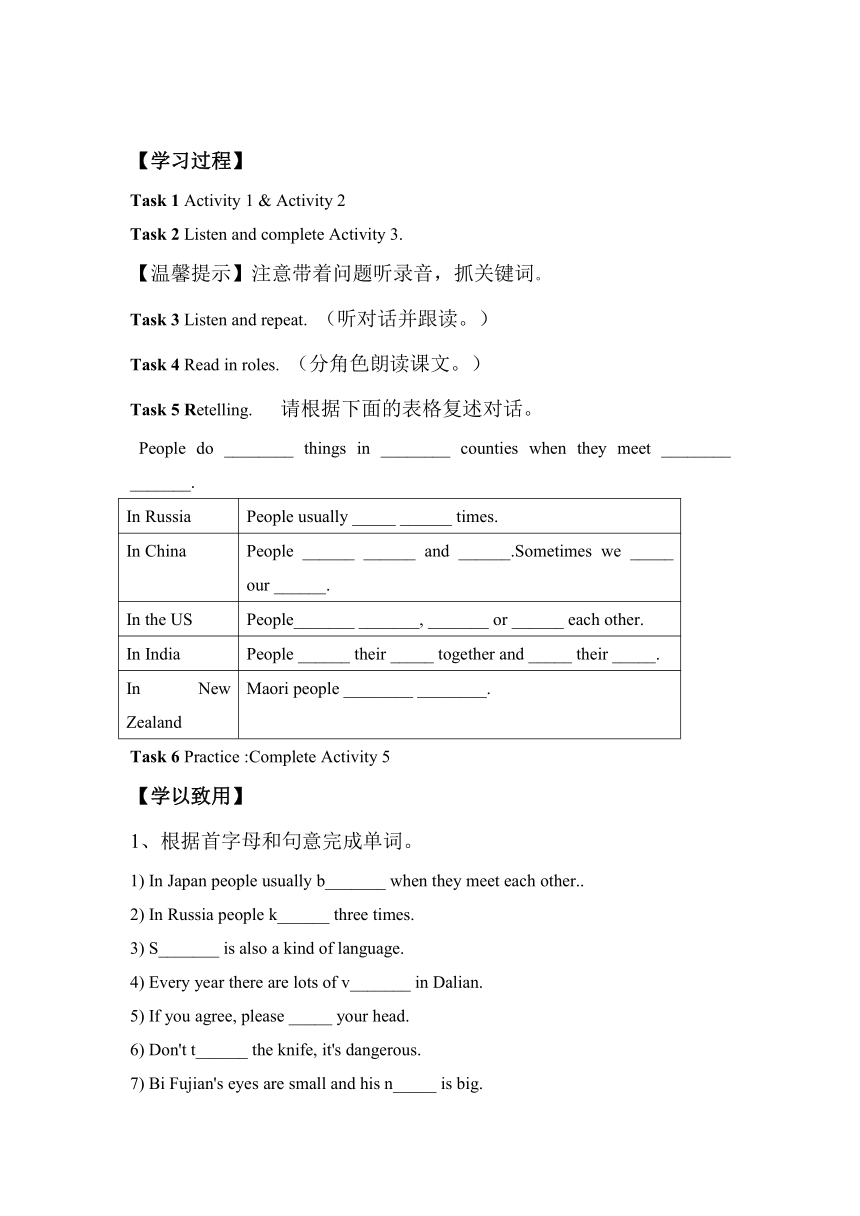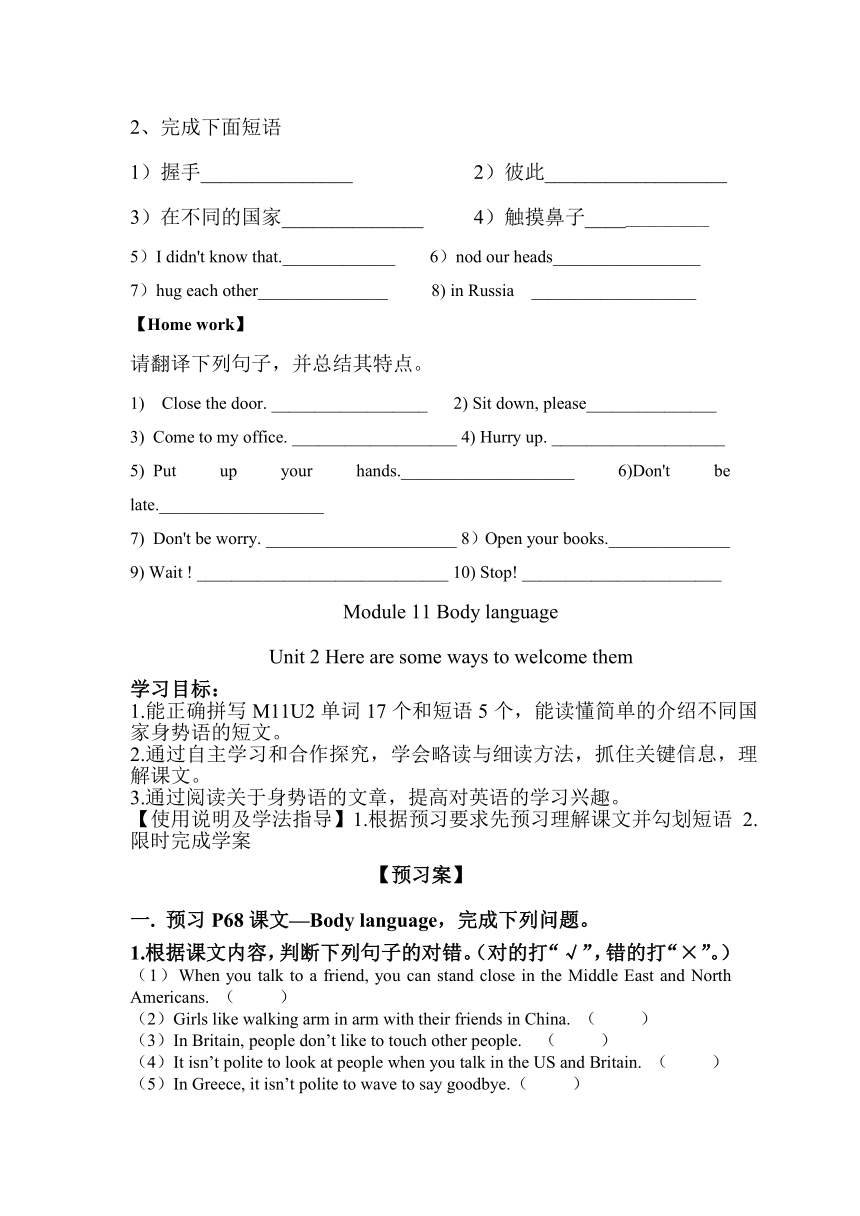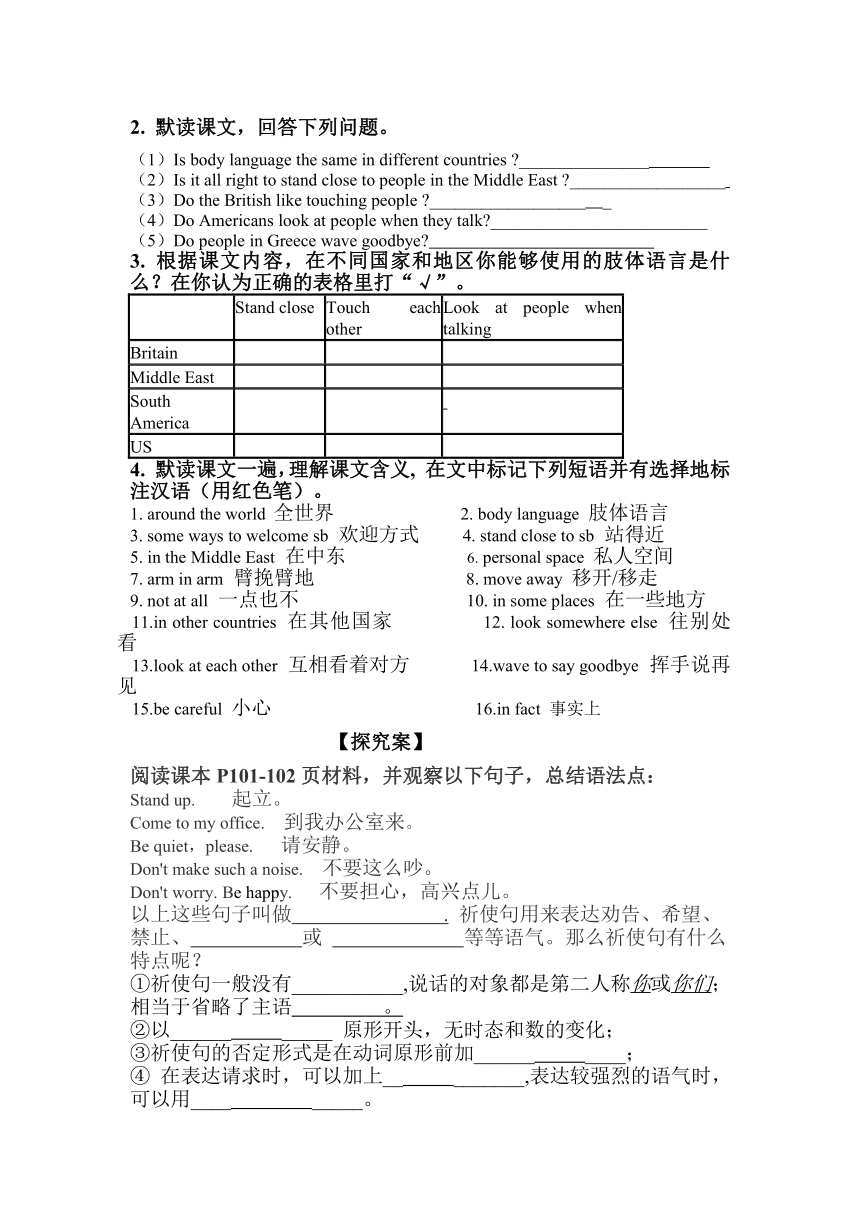Module11 Body language模块导学案
文档属性
| 名称 | Module11 Body language模块导学案 |  | |
| 格式 | zip | ||
| 文件大小 | 1.7MB | ||
| 资源类型 | 教案 | ||
| 版本资源 | 外研版 | ||
| 科目 | 英语 | ||
| 更新时间 | 2015-04-25 17:48:36 | ||
图片预览




文档简介
外研版七年级英语上册导学案
Module11 Body language
Unit1 They touch noses!
【学习目标】
认读与掌握下列单词:bow, kiss, ( http: / / www.21cnjy.com ) shake, smile, British, German, Japanese, Russian, visitor, Russia, what, nod, head, together, touch, nose.
理解并运用下列短语:shake hands, each other, three times.
3、熟练运用下列句型:
① What! ②I didn't know that. ③That's because---
4、了解各国见面礼仪。
【课前预习】
hug bow kiss smile shake hands touch nose
选词填空
( http: / / www.21cnjy.com ) ( http: / / www.21cnjy.com ) ( http: / / www.21cnjy.com )
____________________ ______________ _______________
( http: / / www.21cnjy.com ) ( http: / / www.21cnjy.com ) ( http: / / www.21cnjy.com )
___________________ _________________ ___________________
【学习过程】
Task 1 Activity 1 & Activity 2
Task 2 Listen and complete Activity 3.
【温馨提示】注意带着问题听录音,抓关键词。
Task 3 Listen and repeat. (听对话并跟读。)
Task 4 Read in roles. (分角色朗读课文。)
Task 5 Retelling. 请根据下面的表格复述对话。
People do ________ things in ________ counties when they meet ________ _______.
In Russia People usually _____ ______ times.
In China People ______ ______ and ______.Sometimes we _____ our ______.
In the US People_______ _______, _______ or ______ each other.
In India People ______ their _____ together and _____ their _____.
In New Zealand Maori people ________ ________.
Task 6 Practice :Complete Activity 5
【学以致用】
1、根据首字母和句意完成单词。
1) In Japan people usually b_______ when they meet each other..
2) In Russia people k______ three times.
3) S_______ is also a kind of language.
4) Every year there are lots of v_______ in Dalian.
5) If you agree, please _____ your head.
6) Don't t______ the knife, it's dangerous.
7) Bi Fujian's eyes are small and his n_____ is big.
2、完成下面短语
1)握手_______________ 2)彼此__________________
3)在不同的国家______________ 4)触摸鼻子_______________
5)I didn't know that. ( http: / / www.21cnjy.com )_____________ 6)nod our heads_________________
7)hug each other_______________ 8) in Russia ___________________
【Home work】
请翻译下列句子,并总结其特点。
1) Close the ( http: / / www.21cnjy.com ) door. __________________ 2) Sit down, please_______________
Come to my office. ( http: / / www.21cnjy.com )___________________ 4) Hurry up. ____________________
Put up your hands ( http: / / www.21cnjy.com ).____________________ 6)Don't be late.___________________
Don't be worry. _ ( http: / / www.21cnjy.com )_____________________ 8)Open your books.______________
9) Wait ! _____________________________ 10) Stop! _______________________
Module 11 Body language
Unit 2 Here are some ways to welcome them
学习目标:
1.能正确拼写M11U2单词17个和短语5个,能读懂简单的介绍不同国家身势语的短文。
2.通过自主学习和合作探究,学会略读与细读方法,抓住关键信息,理解课文。
3.通过阅读关于身势语的文章,提高对英语的学习兴趣。
【使用说明及学法指导】1.根据预习要求先预习理解课文并勾划短语 2.限时完成学案
【预习案】
一. 预习P68课文—Body language,完成下列问题。
1.根据课文内容,判断下列句子的对错。(对的打“√”,错的打“×”。)
(1)When you t ( http: / / www.21cnjy.com )alk to a friend, you can stand close in the Middle East and North Americans. ( )
(2)Girls like walking arm in arm with their friends in China. ( )
(3)In Britain, people don’t like to touch other people. ( )
(4)It isn’t ( http: / / www.21cnjy.com )polite to look at people when you talk in the US and Britain. ( )
(5)In Greece, it isn’t polite to wave to say goodbye.( )
2. 默读课文,回答下列问题。
(1)Is body language ( http: / / www.21cnjy.com ) the same in different countries _______________
(2)Is it all right ( http: / / www.21cnjy.com )to stand close to people in the Middle East __________________
(3)Do the British like touching people __________________ _
(4)Do Americans l ( http: / / www.21cnjy.com )ook at people when they talk _________________________
(5)Do people in Greece wave goodbye
3. 根据课文内容,在不同国家和地区你能够使用的肢体语言是什么?在你认为正确的表格里打“√”。
Stand close Touch each other Look at people when talking
Britain
Middle East
South America
US
4. 默读课文一遍,理解课文含义, 在文中标记下列短语并有选择地标注汉语(用红色笔)。
1. around the world 全世界 2. body language 肢体语言
3. some ways to welcome sb 欢迎方式 4. stand close to sb 站得近
5. in the Middle East 在中东 6. personal space 私人空间
7. arm in arm 臂挽臂地 8. move away 移开/移走
9. not at all 一点也不 10. in some places 在一些地方
11.in other countries 在其他国家 12. look somewhere else 往别处看
13.look at each other 互相看着对方 14.wave to say goodbye 挥手说再见
15.be careful 小心 16.in fact 事实上
【探究案】
阅读课本P101-102页材料,并观察以下句子,总结语法点:
Stand up. 起立。
Come to my office. 到我办公室来。
Be quiet,please. 请安静。
Don't make such a noise. 不要这么吵。
Don't worry. Be happ ( http: / / www.21cnjy.com )y. 不要担心,高兴点儿。
以上这些句子叫做 . 祈使句用来表达劝告、希望、禁止、 或 等等语气。那么祈使句有什么特点呢?
①祈使句一般没有___________,说话的对象都是第二人称你或你们;相当于省略了主语 。
②以______ _____ 原形开头,无时态和数的变化;
③祈使句的否定形式是在动词原形前加______ ____;
④ 在表达请求时,可以加上__ _______,表达较强烈的语气时,可以用____ _____。
拓展链接:有时,为了加强语气,可以在 ( http: / / www.21cnjy.com )动词之前加Do.
Do sit down. 务必请坐。
仔细阅读P68课文,你能发现哪些句子是祈使句呢?(动手、动脑,我最棒!)
1、
2、
3、
4、
【训练案】
一、根据首字母完成单词
Our new f___ ____ students are going to arrive very soon.
Please give them more p___________space.
South Americans sometimes h__________your arm when they talk to you.
In some places, it's p__ ______ to look at people when you talk.
In other countries, it's r____ __ to look at people when you talk.
W___ ___ to say goodbye is all right in China.
单项选择
( )1. The TV is too loud. Please________.
A. turn it down B ( http: / / www.21cnjy.com ). to turn it down C. turn down it D. to turn down it
( )2. _______ late again, Bill!
A. Don't to be B. Don't be C. Not be D. Be not
( )3. _______ cross the road until the traffic lights turn green.
A. Not B. Won't C. Doesn't D. Don't
( )4. Kate, _______ your homework here tomorrow.
A. bring B. brings C. to bring D. bringing
( )5. Don't you know that _______ is good for our health
A. swim B. swimming C. swam D. swims
句型转换
1. Will you please read it again more slowly (改为祈使句)
__ ___ __ ___ again more slowly, please.
2. If you don't listen to me, I'll go. (改为同义句)
__ ___ __ ___ me, or I’ll go.
3. The teachers ( http: / / www.21cnjy.com ) often tell the students not to be careless(粗心的). (改为祈使句)
__ ___ __ ___careless, please.
4. Please sit next to Nancy. (改为否定句)
___ __ __ ___ next to Nancy.
Module11 Body language
Unit3 Language in use
【学习目标】
1掌握下列单词:bow, kiss, ( http: / / www.21cnjy.com )shake, smile, British, German, Japanese, Russian, visitor, Russia, what, nod,head, together,touch, nose,finger, foot, knee, leg, mouth, body, foreign, North American, personal, arm, hold, move, polite, somewhere, wave, fact, rude, bring.
2掌握下列短语:shake hands, ( http: / / www.21cnjy.com )each other, three times,arm in arm, not at all, in fact.
3、巩固、运用祈使句。
4、了解各国见面礼仪。
【学习过程】
Task1 关注生活中的“祈使句”
( http: / / www.21cnjy.com )
( http: / / www.21cnjy.com ) ( http: / / www.21cnjy.com ) ( http: / / www.21cnjy.com )
( http: / / www.21cnjy.com ) ( http: / / www.21cnjy.com )
( http: / / www.21cnjy.com ) ( http: / / www.21cnjy.com ) ( http: / / www.21cnjy.com )
( http: / / www.21cnjy.com ) ( http: / / www.21cnjy.com ) ( http: / / www.21cnjy.com )
Task 2 祈使句小结
①祈使句一般没有___________,说话的对象都是第二人称你或你们;
②以___________ 原形开头,无时态和数的变化;
③祈使句的否定形式是在动词原形前加__________;
④ 在表达请求时,可以加上_________,表达较强烈的语气时,可以用_________。
Task3 完成下列短语.
①可以_____________________ ② 臂挽臂地________________________
③吻三次 ____________________④与---握手_________________________
⑤指着 ______________________⑥对不起 __________________________
⑦ show respect ________________⑧ say hello _________________________
⑨ 按时__________________⑩ stand in line _________________________
⑾ clean and ti ( http: / / www.21cnjy.com )dy the lab__________________ ⑿bring --- into --- ______________
☆温馨提示:以上短语都能在本单元找到。
Task4 完成下面单词
1)I'm welcoming the v_________, how do I do that
2)In R_______, people usually kiss three times.
3)We Chinese often ( http: / / www.21cnjy.com )s_______ hands and s_______ when we meet other people.
4)That's b_______ people do different things in different countries.
5)In the US, some people k______ or h_______each other.
6)In India people put their hands t________ and n______ their hands.
Maori people t______noses when they meet.
Our new f_______ students are going to arrive very soon.
Please give them more p___________space.
South Americans sometimes h__________your arm when they talk to you.
In some places, it's p________ to look at people when you talk.
In other countries, it's r______ to look at people when you talk.
W______ to say goodbye is all right in China.
☆温馨提示: 以上句子都是课本上的,做完以后可以查课本核对。
Module11 Body language
Unit1 They touch noses!
【学习目标】
认读与掌握下列单词:bow, kiss, ( http: / / www.21cnjy.com ) shake, smile, British, German, Japanese, Russian, visitor, Russia, what, nod, head, together, touch, nose.
理解并运用下列短语:shake hands, each other, three times.
3、熟练运用下列句型:
① What! ②I didn't know that. ③That's because---
4、了解各国见面礼仪。
【课前预习】
hug bow kiss smile shake hands touch nose
选词填空
( http: / / www.21cnjy.com ) ( http: / / www.21cnjy.com ) ( http: / / www.21cnjy.com )
____________________ ______________ _______________
( http: / / www.21cnjy.com ) ( http: / / www.21cnjy.com ) ( http: / / www.21cnjy.com )
___________________ _________________ ___________________
【学习过程】
Task 1 Activity 1 & Activity 2
Task 2 Listen and complete Activity 3.
【温馨提示】注意带着问题听录音,抓关键词。
Task 3 Listen and repeat. (听对话并跟读。)
Task 4 Read in roles. (分角色朗读课文。)
Task 5 Retelling. 请根据下面的表格复述对话。
People do ________ things in ________ counties when they meet ________ _______.
In Russia People usually _____ ______ times.
In China People ______ ______ and ______.Sometimes we _____ our ______.
In the US People_______ _______, _______ or ______ each other.
In India People ______ their _____ together and _____ their _____.
In New Zealand Maori people ________ ________.
Task 6 Practice :Complete Activity 5
【学以致用】
1、根据首字母和句意完成单词。
1) In Japan people usually b_______ when they meet each other..
2) In Russia people k______ three times.
3) S_______ is also a kind of language.
4) Every year there are lots of v_______ in Dalian.
5) If you agree, please _____ your head.
6) Don't t______ the knife, it's dangerous.
7) Bi Fujian's eyes are small and his n_____ is big.
2、完成下面短语
1)握手_______________ 2)彼此__________________
3)在不同的国家______________ 4)触摸鼻子_______________
5)I didn't know that. ( http: / / www.21cnjy.com )_____________ 6)nod our heads_________________
7)hug each other_______________ 8) in Russia ___________________
【Home work】
请翻译下列句子,并总结其特点。
1) Close the ( http: / / www.21cnjy.com ) door. __________________ 2) Sit down, please_______________
Come to my office. ( http: / / www.21cnjy.com )___________________ 4) Hurry up. ____________________
Put up your hands ( http: / / www.21cnjy.com ).____________________ 6)Don't be late.___________________
Don't be worry. _ ( http: / / www.21cnjy.com )_____________________ 8)Open your books.______________
9) Wait ! _____________________________ 10) Stop! _______________________
Module 11 Body language
Unit 2 Here are some ways to welcome them
学习目标:
1.能正确拼写M11U2单词17个和短语5个,能读懂简单的介绍不同国家身势语的短文。
2.通过自主学习和合作探究,学会略读与细读方法,抓住关键信息,理解课文。
3.通过阅读关于身势语的文章,提高对英语的学习兴趣。
【使用说明及学法指导】1.根据预习要求先预习理解课文并勾划短语 2.限时完成学案
【预习案】
一. 预习P68课文—Body language,完成下列问题。
1.根据课文内容,判断下列句子的对错。(对的打“√”,错的打“×”。)
(1)When you t ( http: / / www.21cnjy.com )alk to a friend, you can stand close in the Middle East and North Americans. ( )
(2)Girls like walking arm in arm with their friends in China. ( )
(3)In Britain, people don’t like to touch other people. ( )
(4)It isn’t ( http: / / www.21cnjy.com )polite to look at people when you talk in the US and Britain. ( )
(5)In Greece, it isn’t polite to wave to say goodbye.( )
2. 默读课文,回答下列问题。
(1)Is body language ( http: / / www.21cnjy.com ) the same in different countries _______________
(2)Is it all right ( http: / / www.21cnjy.com )to stand close to people in the Middle East __________________
(3)Do the British like touching people __________________ _
(4)Do Americans l ( http: / / www.21cnjy.com )ook at people when they talk _________________________
(5)Do people in Greece wave goodbye
3. 根据课文内容,在不同国家和地区你能够使用的肢体语言是什么?在你认为正确的表格里打“√”。
Stand close Touch each other Look at people when talking
Britain
Middle East
South America
US
4. 默读课文一遍,理解课文含义, 在文中标记下列短语并有选择地标注汉语(用红色笔)。
1. around the world 全世界 2. body language 肢体语言
3. some ways to welcome sb 欢迎方式 4. stand close to sb 站得近
5. in the Middle East 在中东 6. personal space 私人空间
7. arm in arm 臂挽臂地 8. move away 移开/移走
9. not at all 一点也不 10. in some places 在一些地方
11.in other countries 在其他国家 12. look somewhere else 往别处看
13.look at each other 互相看着对方 14.wave to say goodbye 挥手说再见
15.be careful 小心 16.in fact 事实上
【探究案】
阅读课本P101-102页材料,并观察以下句子,总结语法点:
Stand up. 起立。
Come to my office. 到我办公室来。
Be quiet,please. 请安静。
Don't make such a noise. 不要这么吵。
Don't worry. Be happ ( http: / / www.21cnjy.com )y. 不要担心,高兴点儿。
以上这些句子叫做 . 祈使句用来表达劝告、希望、禁止、 或 等等语气。那么祈使句有什么特点呢?
①祈使句一般没有___________,说话的对象都是第二人称你或你们;相当于省略了主语 。
②以______ _____ 原形开头,无时态和数的变化;
③祈使句的否定形式是在动词原形前加______ ____;
④ 在表达请求时,可以加上__ _______,表达较强烈的语气时,可以用____ _____。
拓展链接:有时,为了加强语气,可以在 ( http: / / www.21cnjy.com )动词之前加Do.
Do sit down. 务必请坐。
仔细阅读P68课文,你能发现哪些句子是祈使句呢?(动手、动脑,我最棒!)
1、
2、
3、
4、
【训练案】
一、根据首字母完成单词
Our new f___ ____ students are going to arrive very soon.
Please give them more p___________space.
South Americans sometimes h__________your arm when they talk to you.
In some places, it's p__ ______ to look at people when you talk.
In other countries, it's r____ __ to look at people when you talk.
W___ ___ to say goodbye is all right in China.
单项选择
( )1. The TV is too loud. Please________.
A. turn it down B ( http: / / www.21cnjy.com ). to turn it down C. turn down it D. to turn down it
( )2. _______ late again, Bill!
A. Don't to be B. Don't be C. Not be D. Be not
( )3. _______ cross the road until the traffic lights turn green.
A. Not B. Won't C. Doesn't D. Don't
( )4. Kate, _______ your homework here tomorrow.
A. bring B. brings C. to bring D. bringing
( )5. Don't you know that _______ is good for our health
A. swim B. swimming C. swam D. swims
句型转换
1. Will you please read it again more slowly (改为祈使句)
__ ___ __ ___ again more slowly, please.
2. If you don't listen to me, I'll go. (改为同义句)
__ ___ __ ___ me, or I’ll go.
3. The teachers ( http: / / www.21cnjy.com ) often tell the students not to be careless(粗心的). (改为祈使句)
__ ___ __ ___careless, please.
4. Please sit next to Nancy. (改为否定句)
___ __ __ ___ next to Nancy.
Module11 Body language
Unit3 Language in use
【学习目标】
1掌握下列单词:bow, kiss, ( http: / / www.21cnjy.com )shake, smile, British, German, Japanese, Russian, visitor, Russia, what, nod,head, together,touch, nose,finger, foot, knee, leg, mouth, body, foreign, North American, personal, arm, hold, move, polite, somewhere, wave, fact, rude, bring.
2掌握下列短语:shake hands, ( http: / / www.21cnjy.com )each other, three times,arm in arm, not at all, in fact.
3、巩固、运用祈使句。
4、了解各国见面礼仪。
【学习过程】
Task1 关注生活中的“祈使句”
( http: / / www.21cnjy.com )
( http: / / www.21cnjy.com ) ( http: / / www.21cnjy.com ) ( http: / / www.21cnjy.com )
( http: / / www.21cnjy.com ) ( http: / / www.21cnjy.com )
( http: / / www.21cnjy.com ) ( http: / / www.21cnjy.com ) ( http: / / www.21cnjy.com )
( http: / / www.21cnjy.com ) ( http: / / www.21cnjy.com ) ( http: / / www.21cnjy.com )
Task 2 祈使句小结
①祈使句一般没有___________,说话的对象都是第二人称你或你们;
②以___________ 原形开头,无时态和数的变化;
③祈使句的否定形式是在动词原形前加__________;
④ 在表达请求时,可以加上_________,表达较强烈的语气时,可以用_________。
Task3 完成下列短语.
①可以_____________________ ② 臂挽臂地________________________
③吻三次 ____________________④与---握手_________________________
⑤指着 ______________________⑥对不起 __________________________
⑦ show respect ________________⑧ say hello _________________________
⑨ 按时__________________⑩ stand in line _________________________
⑾ clean and ti ( http: / / www.21cnjy.com )dy the lab__________________ ⑿bring --- into --- ______________
☆温馨提示:以上短语都能在本单元找到。
Task4 完成下面单词
1)I'm welcoming the v_________, how do I do that
2)In R_______, people usually kiss three times.
3)We Chinese often ( http: / / www.21cnjy.com )s_______ hands and s_______ when we meet other people.
4)That's b_______ people do different things in different countries.
5)In the US, some people k______ or h_______each other.
6)In India people put their hands t________ and n______ their hands.
Maori people t______noses when they meet.
Our new f_______ students are going to arrive very soon.
Please give them more p___________space.
South Americans sometimes h__________your arm when they talk to you.
In some places, it's p________ to look at people when you talk.
In other countries, it's r______ to look at people when you talk.
W______ to say goodbye is all right in China.
☆温馨提示: 以上句子都是课本上的,做完以后可以查课本核对。
同课章节目录
- Module 1 Lost and found
- Unit 1 Whose bag is this?
- Unit 2 Are they yours?
- Unit 3 Language in use
- Module 2 What can you do ?
- Unit 1 I can play the piano
- Unit 2 I can run really fast
- Unit 3 Language in use
- Module 3 Making plans
- Unit 1 What are you going to do at the weekends?
- Unit 2 We're going to cheer the players.
- Unit 3 Language in use
- Module 4 Life in the future
- Unit 1 Everyone will study at home
- Unit 2 Every family will have a small plane.
- Unit 3 Language in use
- Module 5 Shopping
- Unit 1 What can I do for you?
- Unit 2 You can buy everything on the Internet
- Unit 3 Language in use
- Module 6 Around town
- Unit 1 Could you tell me how to get to the Nationa
- Unit 2 The London Eye is on your right.
- Unit 3 Language in use
- Revision module A
- Module 7 My past life
- Unit 1 I was born in a small village.
- Unit 2 I was born in Quincy.
- Unit 3 Language in use
- Module 8 Story time
- Unit 1 Once upon a time….
- Unit 2 Goldilocks hurried out of the house.
- Unit 3 Language in use
- Module 9 Life history
- Unit 1 He left school and began work at the age of
- Unit 2 He decided to be an actor.
- Unit 3 Language in use
- Module 10 A holiday journey
- Unit 1 What did you do?
- Unit 2 This morning we took a walk.
- Unit 3 Language in use
- Module 11 Body language
- Unit 1 They touch noses!
- Unit 2 Here are some ways to welcome them.
- Unit 3 Language in use
- Module 12 Western music
- Unit 1 It's so beautiful!
- Unit 2 Vienna is the centre of European classical
- Unit 3 Language in use
- Revision module B
